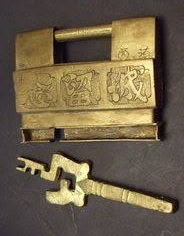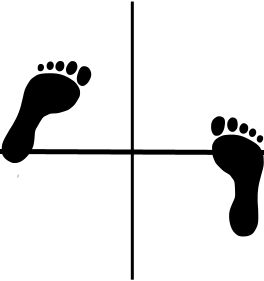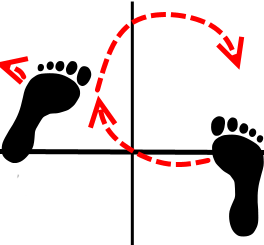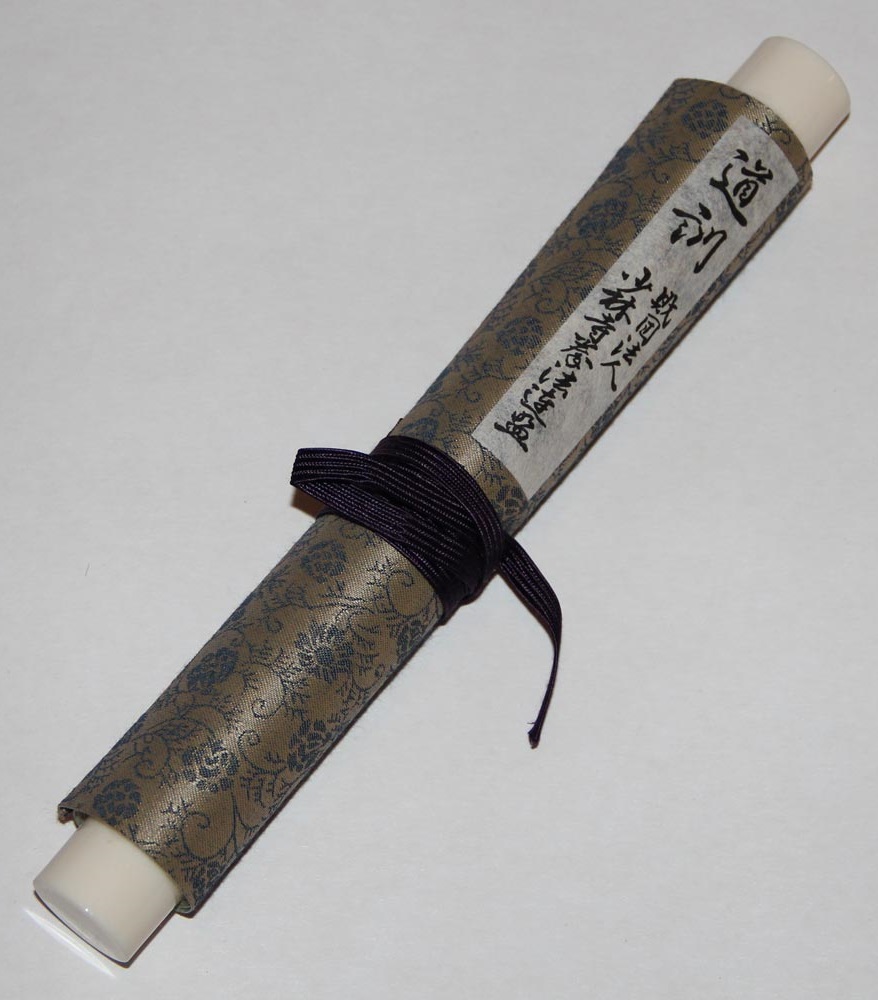Sanchin Description
After bowing and announcing the name of the kata ("Sanchin") ...
Yōi (cross open hands at groin level in
musubi dachi) and kiyomeri kokyū
(purification breaths)
Kamaete (shift both feet simultaneouslyinto nami heikō dachi
while closing hands into fists at hip—not knee—width)
| 1 | Step forward into migi sanchin dachi with morote yoko uke(1) | |
| 2 | In place, slowly hikite(2) with left hand (inhaling fully), slowly gyakuzuki (exhaling fully), then hidari yoko uke whilst inhaling and exhaling fully | |
| 3 | Step forward into hidari sanchin dachi whilst maintaining morote yoko uke | |
| 4 | In place, slowly hikite with right hand (inhaling fully), slowly gyakuzuki (exhaling fully), then migi yoko uke whilst inhaling and exhaling fully | |
| 5 | Step forward into migi sanchin dachi whilst maintaining morote yoko uke | |
| 6 | In place, slowly hikite with left hand (inhaling fully), slowly gyakuzuki (exhaling fully), then hidari yoko uke whilst inhaling and exhaling fully | |
| 7 | Slowly hikite with left hand before moving it across the torso until the fist (palm down) is beneath the right elbow (inhaling fully), turn (Naha-te method) 180 degrees left into hidari sanchin dachi with hidari yoko uke (exhaling partially), slowly migi gyakuzuki (exhaling completely), then migi yoko uke whilst inhaling and exhaling fully | |
| 8 | Step forward into migi sanchin dachi whilst maintaining morote yoko uke | |
| 9 | In place, slowly hikite with left hand (inhaling fully), slowly gyakuzuki (exhaling fully), then hidari yoko uke whilst inhaling and exhaling fully | |
| 10 | Slowly hikite with left hand before moving it across the torso until the fist (palm down) is beneath the right elbow (inhaling fully), turn (Naha-te method) 180 degrees left into hidari sanchin dachi with hidari yoko uke (exhaling partially), slowly migi gyakuzuki (exhaling completely), then migi yoko uke whilst inhaling and exhaling fully | |
| 11 | Step forward into migi sanchin dachi whilst maintaining morote yoko uke | |
| 12 | In place, slowly hikite with left hand (inhaling fully), slowly gyakuzuki (exhaling fully), then hidari yoko uke whilst inhaling and exhaling fully | |
| 13 | In place, slowly hikite with right hand (inhaling fully), slowly gyakuzuki (exhaling fully), then migi yoko uke whilst inhaling and exhaling fully | |
| 14 | In place, slowly hikite with left hand (inhaling fully), slowly gyakuzuki (exhaling fully) | |
| 15 | Begin left hand hikite (inhaling), but at halfway point drive both hands forward with chūdan morote nukite zuki (palms down) whilst exhaling fully and sharply in a silent kiai | |
| 16 | In place, slowly hikite with both hands (inhaling fully) and slowly chūdan morote nukite zuki (exhaling fully) three more times | |
| 17 | Step back with right foot into hidari sanchin dachi with mawari uke (ude-karami nage), inhaling fully during the hikite portion and exhaling fully during the shōtei oshi portion | |
| 18 | Step back with right foot into migi sanchin dachi with mawari uke (ude-karami nage), inhaling fully during the hikite portion and exhaling fully during the shōtei oshi portion |
.......... NOTE: zanshin yame is NOT
performed in Shinsei
Naotte (perform tekagami movement while
drawing left foot back into musubi dachi)
Rei (bow)


 As
shown in the diagram at left, sanchin dachi is shoulder
width from heel to heel, with the heel of the leading
foot (left foot in the diagram) aligned with the ball of
the trailing foot (right foot in the diagram). The
outside edge (sokutō) of the trailing foot is
parallel to the direction of the stance, as in heikō
dachi, but the sokutō of the leading foot is angled
inwards about 30 degrees. Your body weight should
be centered between the feet, both side-to-side and
front-to-back, as indicated by the intersection point
(+) of the vertical and horizontal centre-lines in the
diagram. Ankles, knees, and hips should all be bent
so that your height is the same as in han-zenkutsu
dachi, but the back and neck must remain straight; not
bent or hunched forward.
As
shown in the diagram at left, sanchin dachi is shoulder
width from heel to heel, with the heel of the leading
foot (left foot in the diagram) aligned with the ball of
the trailing foot (right foot in the diagram). The
outside edge (sokutō) of the trailing foot is
parallel to the direction of the stance, as in heikō
dachi, but the sokutō of the leading foot is angled
inwards about 30 degrees. Your body weight should
be centered between the feet, both side-to-side and
front-to-back, as indicated by the intersection point
(+) of the vertical and horizontal centre-lines in the
diagram. Ankles, knees, and hips should all be bent
so that your height is the same as in han-zenkutsu
dachi, but the back and neck must remain straight; not
bent or hunched forward. When moving in sanchin dachi, the
active foot slides across the floor in an elliptical
pattern, as depicted in the diagram at right, its path
nearly grazing the stationary foot as it passes, then
sweeping forward to a point well beyond its final
position before circling back to its ending point less
than a single foot-length ahead of its starting
position. The stationary foot simply pivots outward on
the heel until its sokutō (outer edge) is
parallel to the direction of the stance.
When moving in sanchin dachi, the
active foot slides across the floor in an elliptical
pattern, as depicted in the diagram at right, its path
nearly grazing the stationary foot as it passes, then
sweeping forward to a point well beyond its final
position before circling back to its ending point less
than a single foot-length ahead of its starting
position. The stationary foot simply pivots outward on
the heel until its sokutō (outer edge) is
parallel to the direction of the stance. When
learning any new kata, it is important to remind
oneself of the adage: "Manabu no tame ni hyakkkai,
jukuren no tame ni senkai, satori no tame ni manga
okonau" (学ぶのために百回、熟練のために千回、悟りのために万回行う.).
A hundred times to learn, a thousand
times for proficiency, ten thousand
repetitions for complete understanding.
A related Okinawan saying is "ichi kata san nen"
(一型三年): one kata three years. Think
of it this way: it takes about 40 seconds to
perform Shinsei. So in just ten
minutes per day for only ten days (or twenty minutes a
day for just five days), you can learn the correct
sequences of movements in Shinsei.
But to become truly proficient-to be able to perform it
correctly, and with the speed, power, timing, and bushi damashii (samurai spirit) necessary
to make its techniques effective in a real self-defence
situation will take a thousand repetitions, which
equates to 100 days at ten repetitions a day.
And to fully understand and apply all of its principles,
nuances, and variations will take 1,000 days (three
years) at ten repetitions per day.
When
learning any new kata, it is important to remind
oneself of the adage: "Manabu no tame ni hyakkkai,
jukuren no tame ni senkai, satori no tame ni manga
okonau" (学ぶのために百回、熟練のために千回、悟りのために万回行う.).
A hundred times to learn, a thousand
times for proficiency, ten thousand
repetitions for complete understanding.
A related Okinawan saying is "ichi kata san nen"
(一型三年): one kata three years. Think
of it this way: it takes about 40 seconds to
perform Shinsei. So in just ten
minutes per day for only ten days (or twenty minutes a
day for just five days), you can learn the correct
sequences of movements in Shinsei.
But to become truly proficient-to be able to perform it
correctly, and with the speed, power, timing, and bushi damashii (samurai spirit) necessary
to make its techniques effective in a real self-defence
situation will take a thousand repetitions, which
equates to 100 days at ten repetitions a day.
And to fully understand and apply all of its principles,
nuances, and variations will take 1,000 days (three
years) at ten repetitions per day.